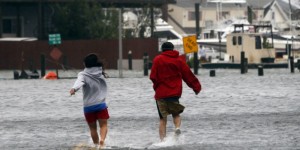
People run through a flooded street as Hurricane Sandy approaches, Monday, Oct. 29, 2012, in Lindenhurst, N.Y. Hurricane Sandy continued on its path Monday, as the storm forced the shutdown of mass transit, schools and financial markets, sending coastal residents fleeing, and threatening a dangerous mix of high winds and soaking rain. AP Photo/Jason DeCrow
WASHINGTON—As the US East Coast slowly cleaned up from superstorm Sandy, those hoping to help the millions without power or food took to tweeting, posting and crowdsourcing Wednesday to mobilize much-needed aid.
The storm has devastated New York City and neighboring New Jersey, killed dozens of people in several states, swamped miles of coastline, and left millions in the dark and some urban public transport systems paralyzed.
On Twitter, users adopted the hashtags #sandyaid and #sandyvolunteer to ask for relief or find out how they could help, and crowdsourced maps sprung up online showing functioning Wi-Fi spots or places where supplies are available.
“In east Williamsburg, how can I help?” @honeybaked_sam tweeted, getting a prompt reply from Brooklyn-based lifestyle guide @BrooklynExposed, which posted a link to nearby volunteering opportunities.
Jessica Lawrence, managing director of NY Tech Meetup — a non-profit organization that supports the technology community in New York — said she had reached out to her 28,000-plus members through Twitter and Facebook.
Already 140 tech-savvy people were on standby to help stricken schools, businesses and other entities to get back on their feet, to provide assistance with tech-related issues such as data recovery.
But in hard-hit Lower Manhattan, many of those in need were still lacking power and Lawrence said the challenge was how to connect with them, though some were now making their way to places with electricity and Internet access.
She added that social networks had been particularly useful to connect with other relief organizations, and make sure they worked together rather than overlapping in their efforts.
“I don’t think it would have been nearly as easy without social media,” she said.
Other organizations used social networks to gather practical information for storm victims and put them on interactive online maps.
The Watershed Post, for instance — an online news source for counties in mountainous areas north of New York City — launched a crowdsourced map locating closed or reopened roads, places to get help or zones in need of aid.
Another crowdsourced map focusing on the New York City area — https://sandycommsmap.crowdmap.com/main — pinpointed places where free Wi-Fi was available and working.
One widely retweeted initiative allowed web users to go to a site called recovers.org and click on a specific stricken location — they can either request assistance or write a list of items they are willing to give away.
A volunteer running the initiative in the Red Hook neighborhood of Brooklyn told AFP the initiative was “very successful” and that she had been able to connect people with those who could help them.
In New Jersey, meanwhile, JSHN — a news outlet set up after Hurricane Irene struck in 2011 — used its Facebook page as a platform to enable people to help each other out.
“Where can we find gas, food, ice, generators, etc???” read one post on the page that had garnered 215 comments so far from web users listing specific addresses and shops where these items were available.